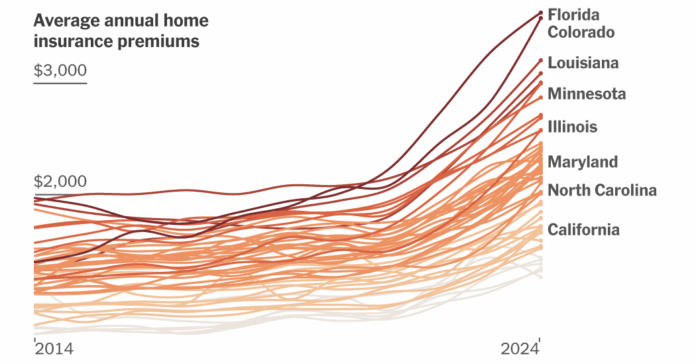Insurance premiums are rising fast in the parts of the United States most exposed to climate-related disasters like wildfires and hurricanes.
New research shows that, as insurance has sharply pushed up the cost of owning a home, the price shock is starting to reverberate through the broader real estate market.
Rising insurance costs are eating into household budgets.
In some areas of the country that are exposed to disasters, homes are not selling because prospective buyers can’t afford both the mortgage and the insurance.
In parts of the hail-prone Midwestern states, insurance now eats up more than one-fifth of the average homeowner’s total housing payments, including mortgage costs and property taxes. In Orleans Parish, La., that number is nearly 30 percent.
Home insurance costs have soared where climate hazards are highest.
Nationally, insurance rates have risen by an average of 58 percent since 2018, outpacing inflation by a substantial margin. But that growth has been highly uneven across the United States.
Places that are most vulnerable to climate-related disasters like hurricanes, fires and hail are seeing some of the largest premium increases. It’s not always the case that the highest climate risk translates into the highest insurance costs. Local policies and regulations have helped keep prices lower in high-risk places, like parts of California. Other factors, like a homeowner’s credit score, can affect premiums, too.
What’s driving up insurance prices?
Since 2017, an obscure part of the insurance market, known as reinsurance, has helped push up premiums. Insurance companies buy reinsurance to help limit their exposure when a catastrophe hits. Over the past several years, reinsurance companies have experienced what Benjamin Keys and Philip Mulder, the researchers who led the new study, call a “climate epiphany.” As a result, the rates they charge to protect home insurance companies against catastrophic losses have roughly doubled.
Insurance providers have, in turn, passed these costs on to homeowners. The rapid repricing of climate risk is responsible for about 20 percent of home insurance premium increases since 2017, according to Dr. Keys and Dr. Mulder.
What else is contributing to high rates? Rebuilding costs are responsible for about 35 percent of the recent changes, the research found. Population shifts and inflation are factors, too.
High insurance prices are weighing down home values.
Since 2018, a financial shock in the home insurance market has meant that homes in the ZIP codes most exposed to hurricanes and wildfires sell for an average of $43,900 less than they otherwise would have, the research found.
In many places, insurance has been a relatively small part of the homebuying equation. Now, for many, it’s a major consideration.
For several homeowners we interviewed in Louisiana, monthly insurance costs are now higher than their home loan payments.
The research shows buyers may be factoring rising insurance costs into the prices they’re willing to pay for homes. As a result, homes in some areas are selling for less.
Methodology
Benjamin Keys and Philip Mulder calculated annual homeowners’ insurance costs by separating mortgage and tax payments from loan-level escrow data obtained from CoreLogic, a property and risk analytics firm. Households whose payments were captured by CoreLogic were not necessarily present in all years of data from 2014 to 2024.
The home insurance share of total home payments is based on mean values. Total home payments include insurance, property tax and mortgage principal and interest costs. Escrow payments typically do not include utilities, homeowners’ association fees.


